�
Afterword
When writing about data compression, I am haunted by the idea that many of the techniques
discussed in this book have been patented by their inventors or others. The knowledge that a data
compression algorithm can effectively be taken out of the hands of programmers through the use of
so-called “intellectual property” law seems contrary to the basic principles that led me and many
others into this profession.
I have yet to see any evidence that applying patents to software advances that art or protects the
rights of inventors. Several companies continue to collect royalties on patents long after their
inventors have moved onto bigger and better thing with other companies. Have the patent-holders
done anything notable other than collect royalties? Have they advanced the art of computer science?
Making a software product into a commercial success requires innovation, good design, high-quality
documentation, and listening to customers. These are things that nobody can steal from you. On the
other hand, a mountain of patents can’t keep you from letting these things slip away through
inattention or complacency. This lesson seems to be lost on those who traffic in intellectual property
“portfolios.”
What can you do? First, don’t patent your own work, and discourage your peers from doing so.
Work on improving your products, not erecting legal obstacles to competition. Secondly, lobby for
change. This means change within your company, those you do business with, and most importantly,
within the federal government. Write to your congressman and your senator. Write to the ACM.
Write to the House Subcommittee on Intellectual Property. And finally, you can join me by
becoming a member of the League for Programming Freedom. Write for more information:
League For Programming Freedom
1 Kendall Square #143
P.O. Box 9171
Cambridge, MA 02139
I concluded, we kinotropists must be numbered among Britain's most adept programmers of
Enginery of any sort, and virtually all advances on the compression of data have originated as
kinotropic applications.
At this point, he interrupted again, asking if I had indeed said "the compression of data," and was I
familiar with the term "algorithmic compression"? I assured him I was.
The Difference Engine
William Gibson and Bruce Sterling
Why This Book Is For You
If you want to learn how programs like PKZIP and LHarc work, this book is for you. The
compression techniques used in these programs are described in detail, accompanied by working
code. After reading this book, even the novice C programmer will be able to write a complete
compression/archiving program that can be ported to virtually any operating system or hardware
platform.
If you want to include data compression in other programs you write, this book will become an
invaluable tool. It contains dozens of working programs with C code that can easily be added to your
applications. In-depth discussions of various compression methods will help you make intelligent
decisions when creating programs that use data compression.
If you want to learn why lossy compression of graphics is the key factor in enabling the multimedia
revolution, you need this book. DCT-based compression like that used by the JPEG algorithm is
described in detail. The cutting edge technology of fractal compression is explained in useful terms,
instead of the purly theoretical. Working programs let you experiment with these fascinating new
technologies.
The Data Compression Book provides you with a comprehensive reference to this important field.
No other book available has the detailed description of compression algorithms or working C
implementations for those algorithms. If you are planning to work in this field, The Data
Compression Book is indispensable.
�
(Imprint: M & T Books)
(Publisher: IDG Books Worldwide, Inc.)
Author: Mark Nelson
ISBN: 1558514341
Afterword
Why This Book Is For You
Chapter 1—Introduction to Data Compression
The Audience
Why C?
Which C?
Keeping Score
The Structure
Issues in Writing Portable C
Chapter 4—A Significant Improvement: Adaptive Huffman Coding
Chapter 2—The Data-Compression Lexicon, with a History
The Two Kingdoms
Data Compression = Modeling + Coding
The Dawn Age
Coding
Chapter 3—The Dawn Age: Minimum Redundancy Coding
An Improvement
Modeling
Statistical Modeling
Dictionary Schemes
Ziv and Lempel
LZ77
LZ78
Lossy Compression
Programs to Know
The Shannon-Fano Algorithm
The Huffman Algorithm
Huffman in C
BITIO.C
A Reminder about Prototypes
MAIN-C.C AND MAIN-E.C
MAIN-C.C
ERRHAND.C
Into the Huffman Code
Counting the Symbols
Saving the Counts
Building the Tree
Using the Tree
The Compression Code
Putting It All Together
Performance
Adaptive Coding
Updating the Huffman Tree
What Swapping Does
�
The Algorithm
An Enhancement
The Escape Code
The Overflow Problem
A Rescaling Bonus
The Code
Initialization of the Array
The Compress Main Program
The Expand Main Program
Encoding the Symbol
Updating the Tree
Decoding the Symbol
The Code
Chapter 5—Huffman One Better: Arithmetic Coding
Difficulties
Arithmetic Coding: A Step Forward
Practical Matters
A Complication
Decoding
Where’s the Beef?
The Code
The Compression Program
The Expansion Program
Initializing the Model
Reading the Model
Initializing the Encoder
The Encoding Process
Flushing the Encoder
The Decoding Process
Summary
Code
Chapter 6—Statistical Modeling
Higher-Order Modeling
Finite Context Modeling
Adaptive Modeling
A Simple Example
Using the Escape Code as a Fallback
Improvements
Highest-Order Modeling
Updating the Model
Escape Probabilities
Scoreboarding
Data Structures
The Finishing Touches: Tables –1 and –2
Model Flushing
Implementation
Conclusions
Enhancement
ARITH-N Listing
Chapter 7—Dictionary-Based Compression
An Example
�
The Algorithm
Problems with LZ77
An Encoding Problem
LZSS Compression
Data Structures
A Balancing Act
Greedy vs. Best Possible
The Code
Constants and Macros
Global Variables
The Compression Code
Initialization
The Main Loop
The Exit Code
AddString()
DeleteString()
Binary Tree Support Routines
The Expansion Routine
Improvements
The Code
Chapter 9—LZ78 Compression
Can LZ77 Improve?
Enter LZ78
LZ78 Details
LZ78 Implementation
An Effective Variant
Decompression
Static vs. Adaptive
Adaptive Methods
A Representative Example
Israeli Roots
History
ARC: The Father of MS-DOS Dictionary Compression
Dictionary Compression: Where It Shows Up
Danger Ahead—Patents
Conclusion
Chapter 8—Sliding Window Compression
The Catch
LZW Implementation
Tree Maintenance and Navigation
Compression
Decompression
The Code
Improvements
Patents
Chapter 10—Speech Compression
Digital Audio Concepts
Fundamentals
Sampling Variables
PC-Based Sound
Lossless Compression of Sound
�
Problems and Results
Lossy Compression
Silence Compression
Companding
Other Techniques
Chapter 11—Lossy Graphics Compression
Enter Compression
Statistical and Dictionary Compression Methods
Lossy Compression
Differential Modulation
Adaptive Coding
A Standard That Works: JPEG
JPEG Compression
The Discrete Cosine Transform
DCT Specifics
Why Bother?
Implementing the DCT
Matrix Multiplication
Continued Improvements
Output of the DCT
Quantization
Selecting a Quantization Matrix
Coding
The Zig-Zag Sequence
Entropy Encoding
What About Color?
The Sample Program
Input Format
The Code
Initialization
The Forward DCT Routine
WriteDCTData()
OutputCode()
File Expansion
ReadDCTData()
Input DCT Codes
The Inverse DCT
The Complete Code Listing
Support Programs
Some Compression Results
Chapter 12—An Archiving Package
CAR and CARMAN
The CARMAN Command Set
The CAR File
The Header
Storing the Header
The Header CRC
Command-Line Processing
Generating the File List
Opening the Archive Files
The Main Processing Loop
Skipping/Copying Input File
�
File Insertion
File Extraction
Cleanup
The Code
Chapter 13—Fractal Image Compression
A brief history of fractal image compression
What is an Iterated Function System?
Basic IFS mathematics
Image compression with Iterated Function Systems
Image compression with Partitioned Iterated Function Systems
Fractal image decoding
Resolution independence
The sample program
The main compression module
Initialization
Domain classification
Image partitioning
Finding optimal affine maps
The decompression module
The complete code listing
Some Compression Results
Patents
Bibliography
Appendix A
Appendix B
Glossary
Index
�
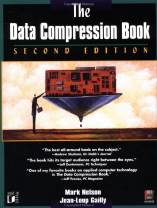
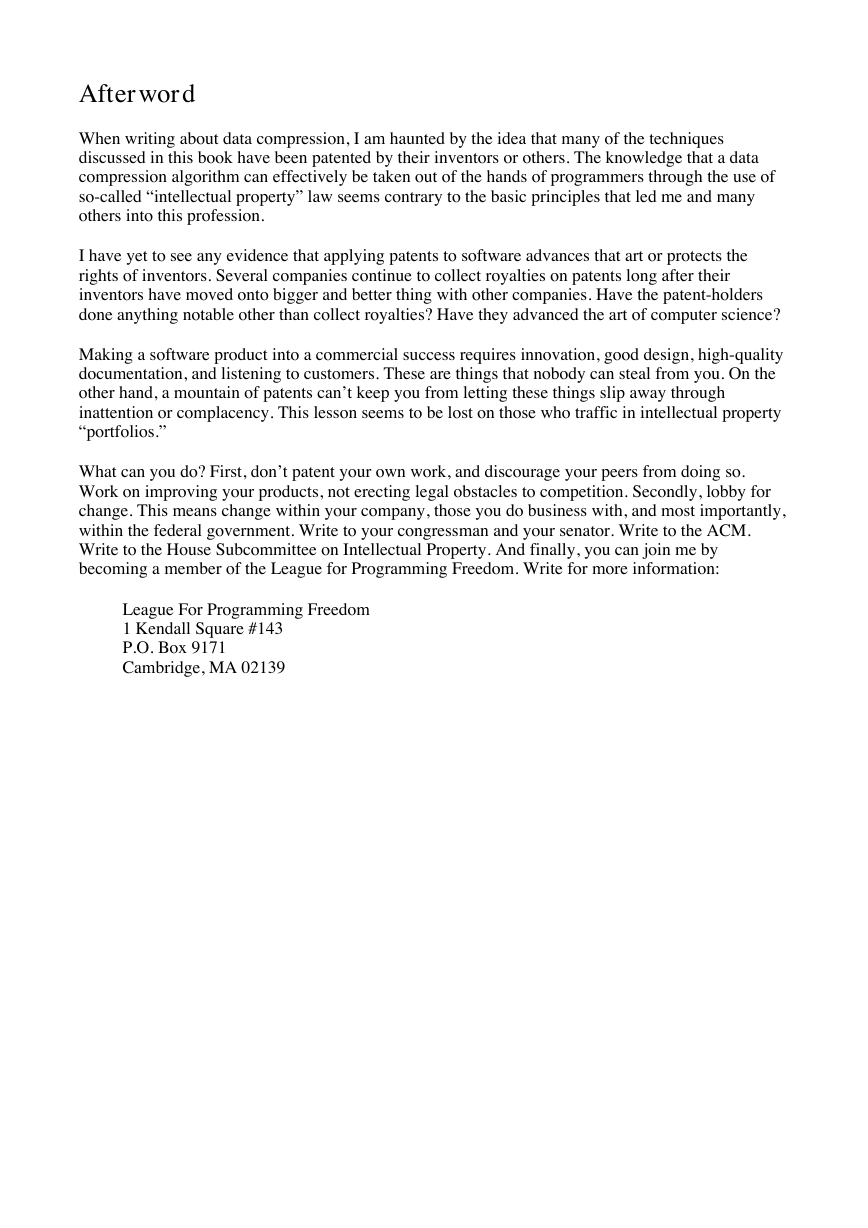
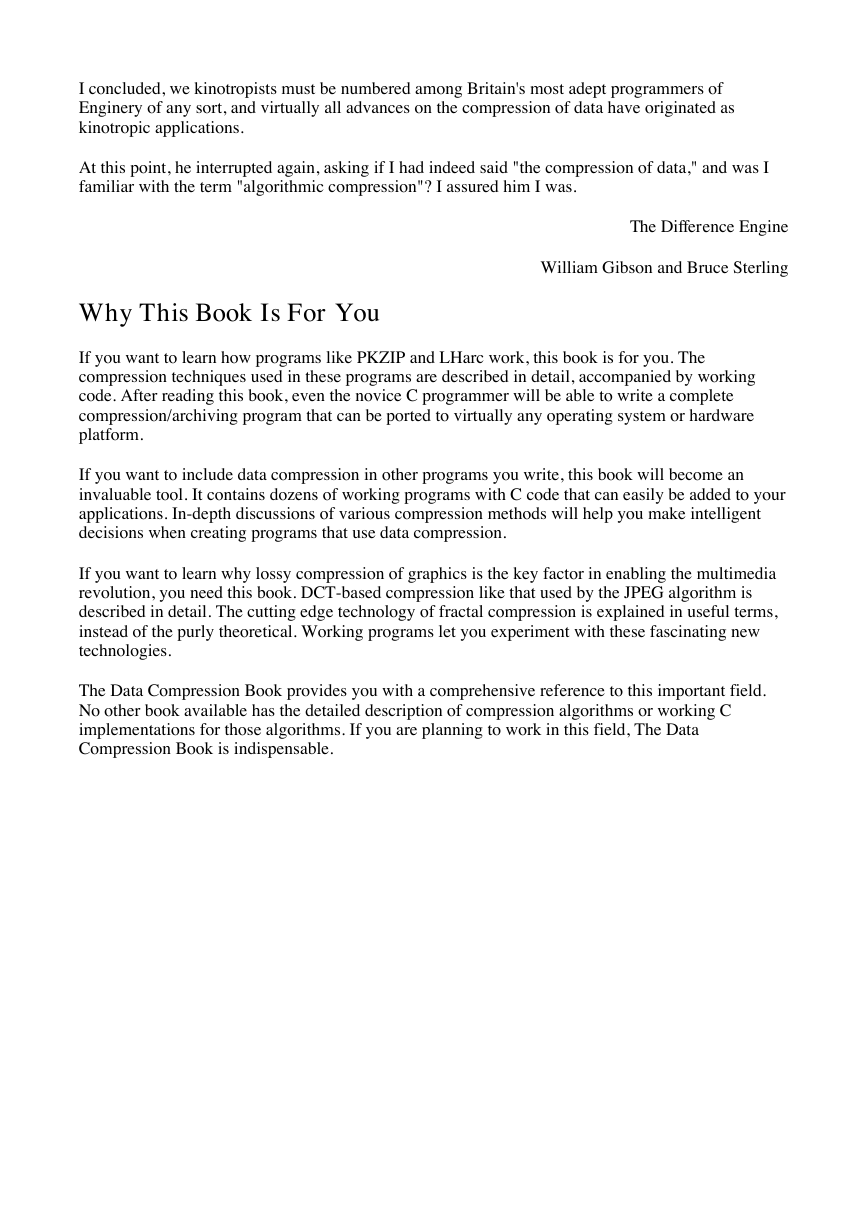
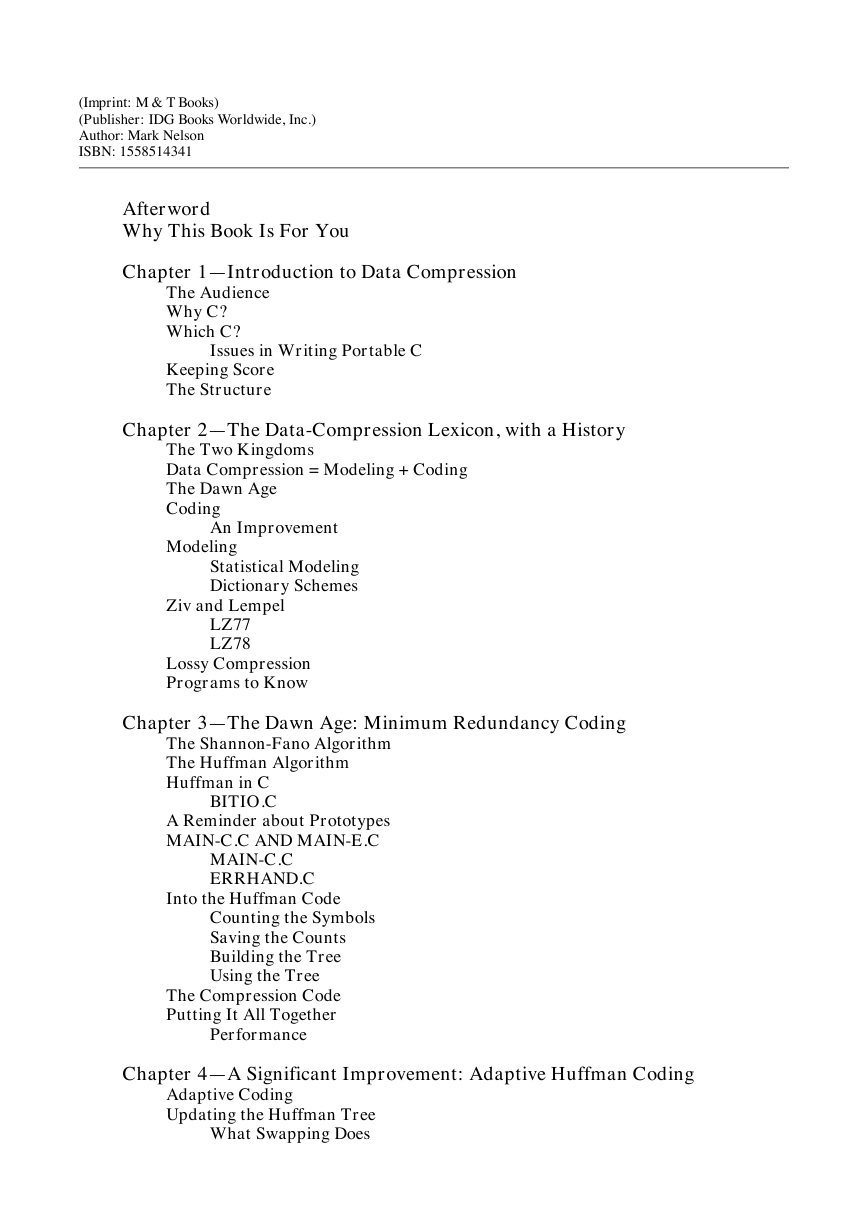
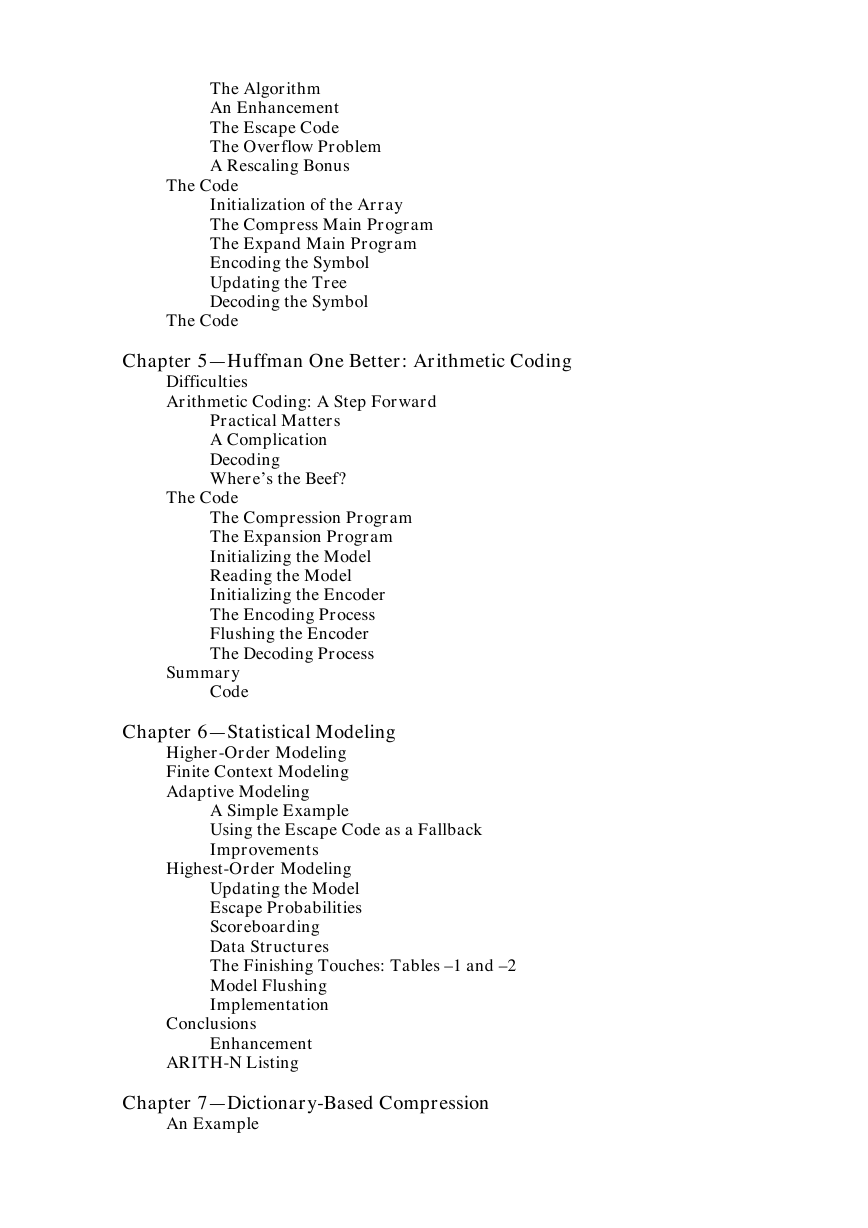
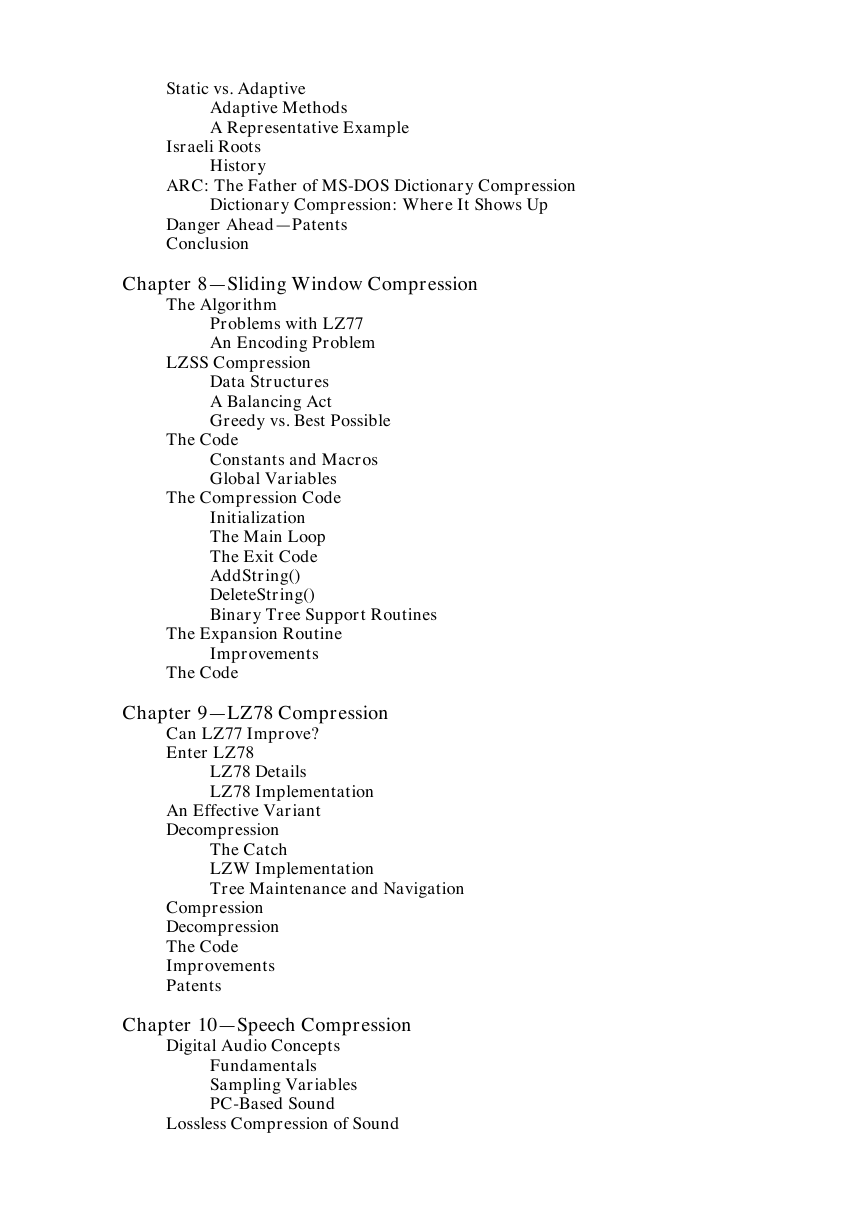
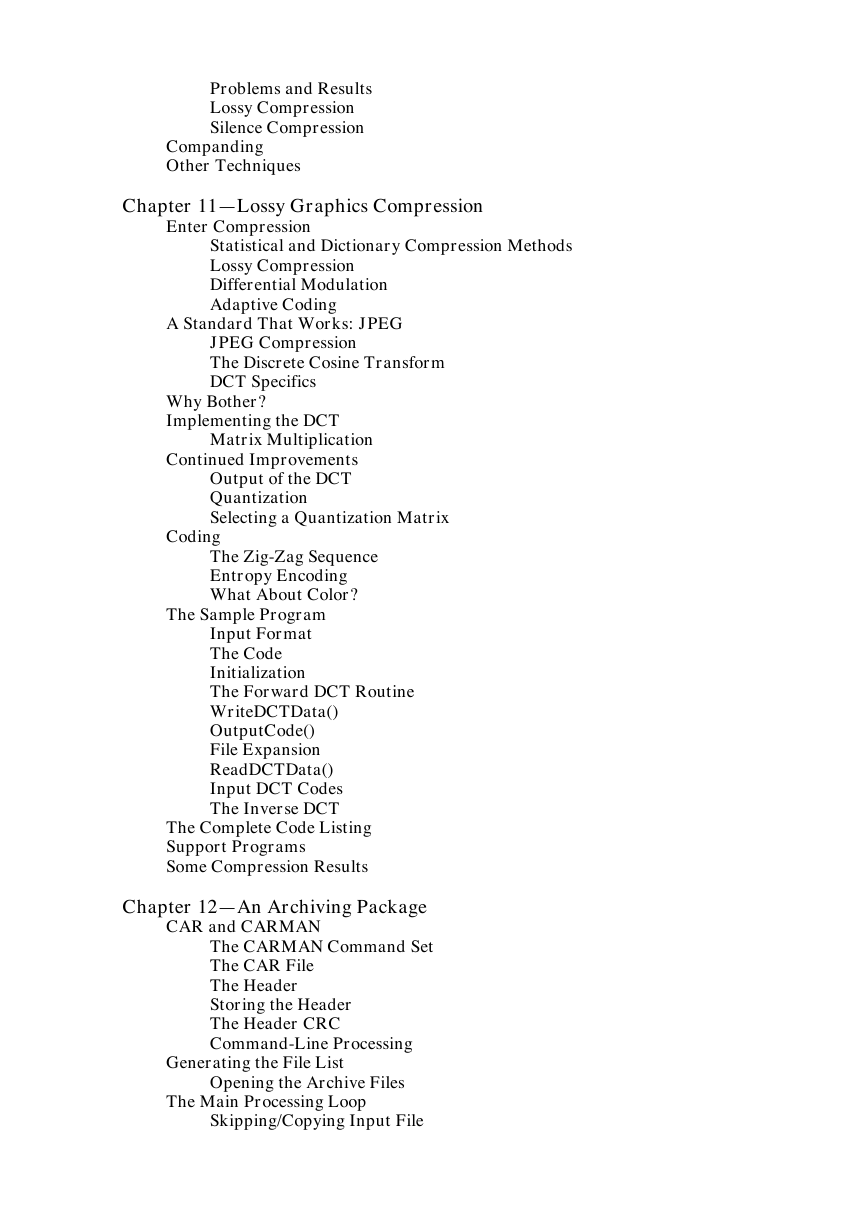
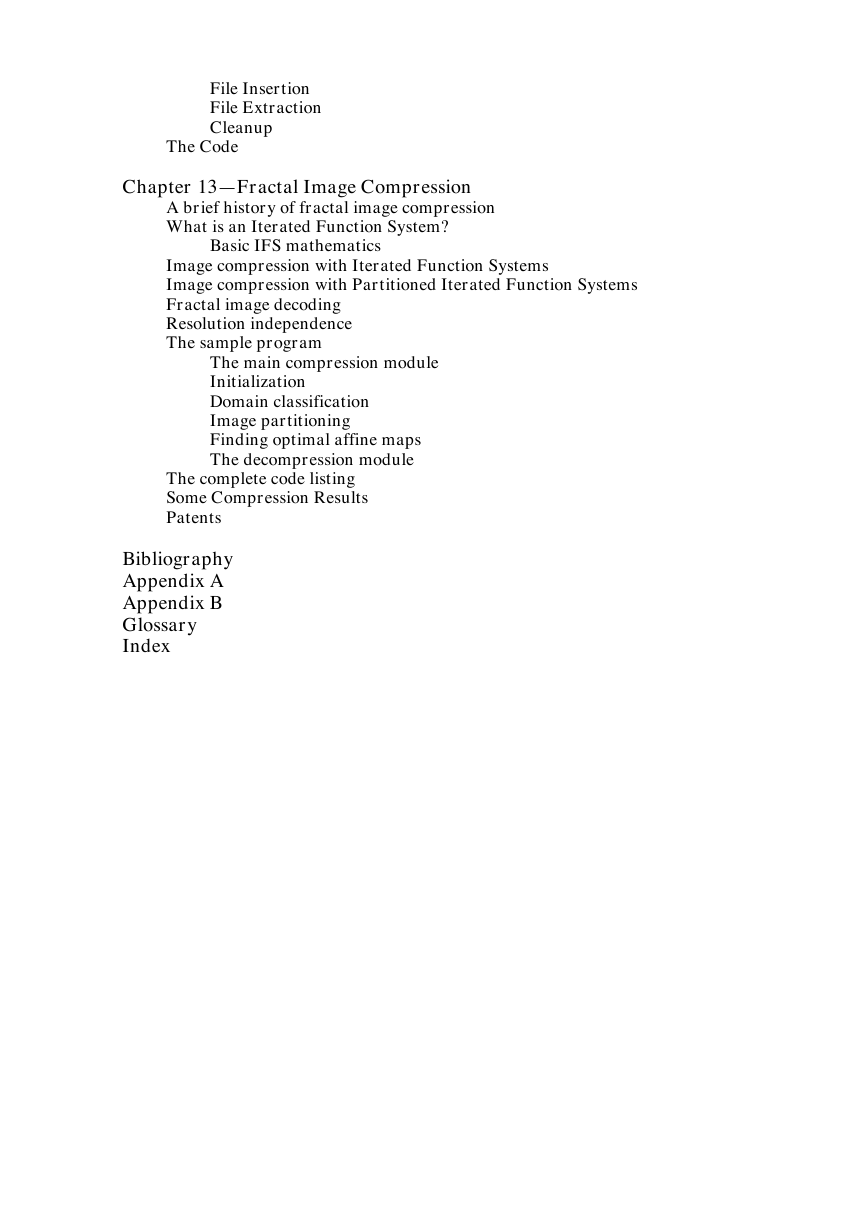








 2023年江西萍乡中考道德与法治真题及答案.doc
2023年江西萍乡中考道德与法治真题及答案.doc 2012年重庆南川中考生物真题及答案.doc
2012年重庆南川中考生物真题及答案.doc 2013年江西师范大学地理学综合及文艺理论基础考研真题.doc
2013年江西师范大学地理学综合及文艺理论基础考研真题.doc 2020年四川甘孜小升初语文真题及答案I卷.doc
2020年四川甘孜小升初语文真题及答案I卷.doc 2020年注册岩土工程师专业基础考试真题及答案.doc
2020年注册岩土工程师专业基础考试真题及答案.doc 2023-2024学年福建省厦门市九年级上学期数学月考试题及答案.doc
2023-2024学年福建省厦门市九年级上学期数学月考试题及答案.doc 2021-2022学年辽宁省沈阳市大东区九年级上学期语文期末试题及答案.doc
2021-2022学年辽宁省沈阳市大东区九年级上学期语文期末试题及答案.doc 2022-2023学年北京东城区初三第一学期物理期末试卷及答案.doc
2022-2023学年北京东城区初三第一学期物理期末试卷及答案.doc 2018上半年江西教师资格初中地理学科知识与教学能力真题及答案.doc
2018上半年江西教师资格初中地理学科知识与教学能力真题及答案.doc 2012年河北国家公务员申论考试真题及答案-省级.doc
2012年河北国家公务员申论考试真题及答案-省级.doc 2020-2021学年江苏省扬州市江都区邵樊片九年级上学期数学第一次质量检测试题及答案.doc
2020-2021学年江苏省扬州市江都区邵樊片九年级上学期数学第一次质量检测试题及答案.doc 2022下半年黑龙江教师资格证中学综合素质真题及答案.doc
2022下半年黑龙江教师资格证中学综合素质真题及答案.doc